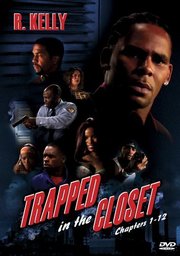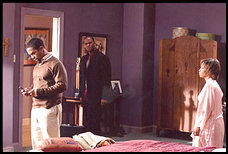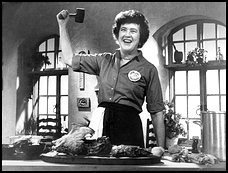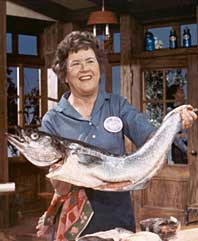 Most of the people reading this blog probably don’t give R. Kelly – the R&B singer known for his buttery voice and slippery morals – the attention that I do, which is completely understandable. But unfortunate, because he’s very much worth keeping an eye on. For the past six months, he’s been engaged in the most formally interesting experiment in pop music in a while. I’m referring, of course, to “Trapped in the Closet”. Bear with me a bit: while it might seem like I’m off on a frolic of my own, this will get around to having something to do with the future of the book.
Most of the people reading this blog probably don’t give R. Kelly – the R&B singer known for his buttery voice and slippery morals – the attention that I do, which is completely understandable. But unfortunate, because he’s very much worth keeping an eye on. For the past six months, he’s been engaged in the most formally interesting experiment in pop music in a while. I’m referring, of course, to “Trapped in the Closet”. Bear with me a bit: while it might seem like I’m off on a frolic of my own, this will get around to having something to do with the future of the book.
“Trapped in the Closet” is, in brief, Kelly’s experiment in making a serialized pop song. The first installment of it (“Chapter 1”) arrived on a CD single last May, squeezed between “Set in the Kitchen” (a song about sex in the kitchen) and “Sex in the Kitchen (remix)” (another song about sex in the kitchen). It’s a three-and-a-half minute long song without a chorus in which Kelly lays out a plot involving multiple adulteries, a closet, and a cell phone that goes off at an inopportune moment. It ends on a cliffhanger – the narrator, hiding in the titular closet, draws his gun as the husband he’s cuckolded is about to open the door. Kelly followed this up by releasing four subsequent chapters to the radio – followed shortly by music videos – which, rather than tying up loose ends, drew out the plot wider and wider, piling adultery upon adultery, bringing a gay pastor, a police officer, and leg cramps into the story. All the chapters have the same backing music and run to the same length. And despite revelation after revelation, they all end on a cliffhanger of some sort.
 For the next seven chapters, Kelly moved directly to video: he’s just released a DVD video of the first twelve chapters, where he and others act out the drama he’s narrating for thirty-nine minutes. New characters are introduced and the plot becomes steadily more labyrinthine (a midget and an allergy to cherries figure prominently) and fails to resolve much of anything. Kelly’s said to be busy thinking up a dozen more installments to the story. Through it all, the music remains the same; each episode is still three minute pop song, which do get played on the radio as such. Wikipedia does have a surprisingly good summary of the twists and turns of Kelly’s saga, though it is written in an unfortunate wink-wink-nudge-nudge style. There’s a video of the first chapter is available here; the Web being the Web, there’s a lot of so-so derivative work here, and even machinima versions of the videos here.
For the next seven chapters, Kelly moved directly to video: he’s just released a DVD video of the first twelve chapters, where he and others act out the drama he’s narrating for thirty-nine minutes. New characters are introduced and the plot becomes steadily more labyrinthine (a midget and an allergy to cherries figure prominently) and fails to resolve much of anything. Kelly’s said to be busy thinking up a dozen more installments to the story. Through it all, the music remains the same; each episode is still three minute pop song, which do get played on the radio as such. Wikipedia does have a surprisingly good summary of the twists and turns of Kelly’s saga, though it is written in an unfortunate wink-wink-nudge-nudge style. There’s a video of the first chapter is available here; the Web being the Web, there’s a lot of so-so derivative work here, and even machinima versions of the videos here.
What’s interesting about this to me? It’s partially interesting for the unbridled creativity of the endeavor: to all appearances, R. Kelly would seem to be making up the story as he goes along, happily jumping between media. But I find the most interesting aspect of this to be that R. Kelly is trying to construct a large story modularly. Each of the chapters of his story ostensibly should be able to have a life of its own as a pop song. This doesn’t quite work because his plot has become fiendishly complicated, and none save the moved devoted can make out exactly what the relationship of Rufus to Bridget might be. Presumably this is why the latest chapters were released straight to DVD, where they play sequentially. But formally each of the chapters remains identical: they all have the same backing music, start with a revelation resolving the previous cliffhanger, and end by setting up a new cliffhanger. These constraints limit what Kelly can do with the song: accordingly, his plots must become progressively more ridiculous to keep the story interesting for his listeners or viewers.
There’s an obvious analogy to the serialized novel, a recurring trope around here – we could once again trot out Charles Dickens (to whom Kelly might have been obliquely referring when he explained that ” ‘Trapped in the Closet’ was designed to go around the world sort of like the Ghost of Christmas Past – house to house, this situation to that situation, sometimes exposing people in their regular lives”). But closer at hand, there’s clearly a relevant comparison to be made to how entries function within a blog here. Just as “Trapped in the Closet” is composed of modular “chapters”, blogs are composed of entries, which are intended to stand by themselves. Kelly’s ongoing opera isn’t quite a blog, but it’s rather similar in structure.
What does it functionally mean to have a serialized narrative? One thing that shouldn’t be forgotten when scrutinizing new media forms is that form inevitably inflicts itself on content. Another: the example par excellence of the serialized narrative is the soap opera, unglamorous as that might be. Because R. Kelly has to end each chapter on a cliffhanger, his plot must become even more convoluted with every chapter. Watching the thirty-nine minutes of Trapped in the Closet Chapters 1–12 is exhausting because of this: a three minute bon bon of plot becomes cloying sweet over time. At thirty-nine minutes, Kelly’s DVD should feel like a movie. It doesn’t: its repetitiveness makes it feels like something else entirely, something that we haven’t quite seen before. Does it work? It’s hard to say.
There’s no lack of connection between the serialized narrative and the new media forms we survey here (note, for example Lisa’s post from today). I’m most interested in the formal problem that arises from the publishing industry’s latest bad idea, making books out of blogs. This does seem appealingly simple: people are writing online, if they’re good and they’ve written enough, you can slap a cover on it and call it a book. It turns out, however, that a book is more than the sum of its parts. I’m willing to give R. Kelly the benefit of the doubt with his strange DVD because it doesn’t quite feel like anything else. The problems with blogs presented as books, however, is that we expect them to behave like a book, which they don’t.
 An example at hand: a friend gave my girlfriend a copy of Julie & Julia, the book that was made from Julie Powell’s blog, in which she reports on her attempts to cook all of the recipes in Julia Child’s Mastering the Art of French Cooking. My girlfriend, a self-identified cookbook snob & long-time devotée of Julia Child, was predictably horrified, and has spent the past week complaining about how dreadful this book is. Part of her anger is an issue of substance: she believes that Julia Child should not be dealt with so flippantly. But part of what makes her angry about the book is how the book is written. It’s not quite episodic – the editor wasn’t quite so sloppy as string together a series of blog posts and call it a book – but it does inherit much of its character from its episodic origin, which is what brings me back around to R. Kelly.
An example at hand: a friend gave my girlfriend a copy of Julie & Julia, the book that was made from Julie Powell’s blog, in which she reports on her attempts to cook all of the recipes in Julia Child’s Mastering the Art of French Cooking. My girlfriend, a self-identified cookbook snob & long-time devotée of Julia Child, was predictably horrified, and has spent the past week complaining about how dreadful this book is. Part of her anger is an issue of substance: she believes that Julia Child should not be dealt with so flippantly. But part of what makes her angry about the book is how the book is written. It’s not quite episodic – the editor wasn’t quite so sloppy as string together a series of blog posts and call it a book – but it does inherit much of its character from its episodic origin, which is what brings me back around to R. Kelly.
What makes a blog readable isn’t the same thing that makes a book readable. The two forms have different concerns: on a blog, an enormous part of the task of the writer is to make sure that what’s written about are interesting enough that readers keep coming back. A reader might start reading a blog at any point, so this is an ongoing concern. (Thus R. Kelly’s cliffhangers.) This isn’t nearly as necessary with a physical book: readers still need to be hooked by the concept of the book, but generally you don’t need to keep hooking them.
 It might be best explained by looking at the difference between Mastering the Art of French Cooking & Powell’s book. The former was conceived as a unified whole: it’s a single big idea, elucidated in steps, from the simple to the complicated. Later parts of that book are built upon the former: they don’t work well by themselves unless you’ve already absorbed the earlier information. Julie & Julia is constructed as a series of snapshots from the life of the author, each of which seeks to be individually interesting in and of itself. How does this play out in the pages of the book? An easy example: Powell’s sex life keeps popping up in a rather gratuitous fashion. The subject isn’t without relevance in a culinary work (M.F.K. Fisher could pull this off this sort of thing astonishingly well, for example); rather, it’s the way in which it’s constantly presented in passing. This makes perfect sense for a blog: a dash of sex spices up a blog entry nicely, and will keep the readers coming back for more. A blog is explicitly built on a relationship between the reader and the writer: the writer can respond to the readers. This doesn’t work so well in a published book: this sort of interjection, rather than serving to keep the reader hooked, feels more like a constant distraction in a book not explicitly about food & sex. The reader’s already bought the book. They don’t need to be hooked again.
It might be best explained by looking at the difference between Mastering the Art of French Cooking & Powell’s book. The former was conceived as a unified whole: it’s a single big idea, elucidated in steps, from the simple to the complicated. Later parts of that book are built upon the former: they don’t work well by themselves unless you’ve already absorbed the earlier information. Julie & Julia is constructed as a series of snapshots from the life of the author, each of which seeks to be individually interesting in and of itself. How does this play out in the pages of the book? An easy example: Powell’s sex life keeps popping up in a rather gratuitous fashion. The subject isn’t without relevance in a culinary work (M.F.K. Fisher could pull this off this sort of thing astonishingly well, for example); rather, it’s the way in which it’s constantly presented in passing. This makes perfect sense for a blog: a dash of sex spices up a blog entry nicely, and will keep the readers coming back for more. A blog is explicitly built on a relationship between the reader and the writer: the writer can respond to the readers. This doesn’t work so well in a published book: this sort of interjection, rather than serving to keep the reader hooked, feels more like a constant distraction in a book not explicitly about food & sex. The reader’s already bought the book. They don’t need to be hooked again.
(Something of a counterexample: one of the most vexing things I found about Thomas de Zengatita’s Mediated (which we recently discussed at the Institute) was the style in which it’s written. Every page or so there’s a pithy, one-sentence paragraph. These zingers are employed over the 200 pages of the book; for the reader, it becomes immensely wearing. But just as a thought-experiment: if Zengotita had chopped the book up into page-sized chunks and turned it into a blog, the single-sentence zingers probably wouldn’t have been so bothersome; I might not have noticed them enough to comment on them. I’ve never found Zengatita’s much shorter essays in Harper’s annoyingly written. Some traits only becomes visible with length or time.)
While it’s very easy to fuse the words blog and book to get blook, that doesn’t automatically mean that a successful blog will become a successful book (or vice versa). These are very different forms. What could Julie Powell have learned from R. Kelly, besides any number of things which can’t be printed in a family-oriented blog? First, it’s a difficult job to make a coherent work out of unified pieces. It’s possible that R. Kelly could wrap up all of his narrative loose ends in future chapters, but I’m not holding my breath. Something else: even if it lacks any Aristotelian unities, “Trapped in the Closet” is interesting because it’s unique. Nobody else is making serialized pop music videos: we have nothing to judge it against, so it has novelty. (Yes, this might be damning with faint praise – that’s the other side of the coin.) A blog turned into a book doesn’t have that same sort of novelty. We end up judging it against the criteria by which we’d judge any other book – we compare Powell’s book to M. F. K. Fisher, though we wouldn’t have thought to do that with her blog. The blook inevitably suffers, because the content has been stuffed into a form which it doesn’t quite fit. Let blogs be blogs.
A question to throw out to end this with: could you develop the sort of big ideas that the physical book excels at moving around on a blog, given their modular construction?
